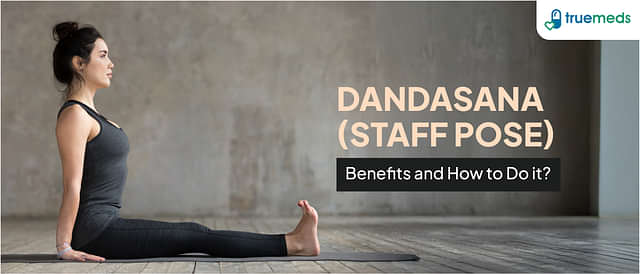Benefits of Vrikshasana (Tree Pose) and How to Do It
Last updated on : 01 Dec, 2025
Read time : 9 min
Yoga, an ancient Indian practice, has become increasingly popular globally for its numerous health benefits. One foundational yoga pose that has garnered much attention is Vrikshasana, also known as the Tree Pose. This balancing asana can provide a strong incentive to incorporate it into your routine, whether you’re a yoga enthusiast or a beginner. In this article, we will explore how to safely practice Vrikshasana and understand its holistic benefits.
What is Vrikshasana (Tree Pose)?
Vrikshasana, or the Tree Pose, is a foundational yoga asana that improves balance, stability, and focus. Its name comes from the Sanskrit words “vriksha”, meaning tree, and “asana”, meaning pose, as the final position resembles a tree standing tall. Executing Vrikshasana involves standing on one leg while positioning the other foot on the inner thigh or calf. The arms can be either extended overhead or brought together at the heart centre in Anjali Mudra (prayer position).
While the pose may look simple, Vrikshasana demands physical stability, mental concentration, and muscular engagement [1]. With regular practice, it helps improve body alignment, strengthens the lower body, and fosters inner calm and focus.
Variations of Vrikshasana for Different Skill Levels
Vrikshasana has several variations designed to cater to different skill levels and physical abilities:
- Classic Vrikshasana: In this traditional pose, you stand on one leg with the opposite foot placed on the inner thigh or calf of the standing leg, avoiding the knee. Your arms are raised overhead or in Anjali Mudra.
- Modified Vrikshasana: This version is suitable for beginners or those facing balance challenges. The lifted foot can rest on the ankle or lower shin instead of the thigh. This provides more stability while still engaging the core.
- Half Lotus Vrikshasana: This is an advanced variation where the foot is placed in a half lotus position on the hip crease of the standing leg. This requires significant hip flexibility and is not recommended for beginners.
- Vrikshasana with Wall Support: Practitioners still developing their balance can use a wall for support. You can place one hand on the wall while balancing on one leg.
- Reclined Vrikshasana: Ideal for individuals unable to stand for long, this version is performed lying down with the sole of one foot resting on the opposite thigh.
These variations ensure Vrikshasana is accessible to a wider range of people, allowing practitioners to explore balance and strength at their own pace.
Steps to Perform Vrikshasana Safely
Vrikshasana can be performed by following these simple steps:
- Begin by standing tall on your yoga mat in Tadasana (Mountain Pose), with your feet together and arms relaxing at your sides.
- Fix your gaze on a point ahead of you that is not moving (Drishti). This focused gaze is crucial for maintaining balance [1].
- Gradually shift your weight onto your left leg, ensuring the left foot is pressing firmly into the mat.
- Bend your right knee and lift your right foot. Place the sole of the right foot on the inner thigh or calf of your left leg. Crucially, avoid placing the foot directly on the knee joint to prevent injury.
- Bring your hands to the heart centre in Anjali Mudra. When stable, you can extend them overhead with palms facing each other.
- Engage your standing leg muscles and core, keeping your body steady. Keep your spine long, resembling a sturdy tree trunk.
- Hold the pose for 15 to 30 seconds while continuing to breathe steadily and deeply.
- To exit the pose, gently lower your right leg and bring down your arms to your sides.
- Repeat the process on the other side for a balanced practice.
Things Required to Practice Vrikshasana
Before you begin practising Vrikshasana, make sure you have the following:
- Yoga Mat: A good-quality non-slip mat is essential for providing stability and comfort during practice.
- Comfortable Clothing: Choose flexible, breathable clothing that allows for free movement.
- Stable Surface: It’s essential to practice on a flat, stable surface to maintain balance.
- Props (Optional): For beginners or those needing additional stability, a wall or chair can be used for support.
Key Benefits of Practising Vrikshasana
The benefits of regular Vrikshasana practice are abundant and diverse, impacting both physical and mental wellness:
- Enhances Balance and Stability: Practising Vrikshasana consistently has been shown to improve dynamic balance and may be beneficial for populations at risk of falls, such as seniors [3], [4].
- Strengthens Leg Muscles: This pose engages and tones the muscles of the standing leg, specifically strengthening the ankles, calves, thighs, and spine [1].
- Improves Posture: By encouraging an upright spine and engaged core, Vrikshasana contributes to better overall postural alignment.
- Fosters Concentration and Mental Clarity: The need to fix your gaze and maintain stability cultivates mindfulness and enhances the ability to concentrate [2].
- Promotes Relaxation and Calm: The meditative and focused aspect of the pose can have a soothing effect on the nervous system, potentially aiding in the reduction of anxiety and stress levels.
Tips for Improving Your Vrikshasana
To perfect your Vrikshasana practice, keep these tips in mind:
- Always focus your gaze on a fixed point in front of you (Drishti).
- Press the four corners of your standing foot firmly into the mat. This grounds you and engages your leg muscles for stability.
- Keep your core engaged by gently drawing your navel towards your spine to maintain good posture and balance.
- If you’re struggling with balance, use a wall or chair for support until your stability improves.
- Remember to breathe deeply and evenly throughout the pose. Shallow breathing can increase tension and compromise balance.
Precautions and Contraindications of Vrikshasana
While Vrikshasana is beneficial, it’s essential to be aware of precautions to ensure a safe practice and prevent injuries:
- Avoid placing the lifted foot directly on the knee joint. This is the most crucial precaution to prevent undue strain on the knee ligaments.
- Refrain from clenching the toes of your standing foot. Instead, try to evenly distribute your weight.
- Try to keep the hips square (facing forward), avoiding letting the lifted hip pop out to the side.
- If you have uncontrolled high blood pressure, it is strongly advised not to raise your arms overhead during this pose [5].
- Individuals with recent ankle or knee injuries, dizziness, or vertigo should approach this pose with caution and use support [5].
Addressing Risks: Common Issues and Who Should Modify or Avoid
Vrikshasana is generally safe, but like any pose, it can cause strain if not practised correctly.
Common Issues:
- Muscle Strain: Overstretching or holding the pose too long can strain muscles in the standing leg, hips, and lower back.
- Joint Strain: Excessive pressure on the standing leg can strain the knee and ankle joints, especially in those with pre-existing issues.
Who Should Modify or Avoid:
- Individuals with recent or chronic knee/ankle injuries should perform a modified version, such as placing the foot only on the lower shin or using wall support.
- Those with high blood pressure should follow the precaution of not raising their arms overhead [5].
- Those experiencing migraines, insomnia, or severe blood pressure fluctuations should consult a yoga therapist or physician before attempting the pose [5].
Remember, yoga is all about listening to your body. Even with the benefits of Vrikshasana, one should not push beyond their limits. With proper alignment, focus, and caution, Vrikshasana can be a safe and beneficial pose for most practitioners.
Frequently Asked Questions (FAQs)
What is the best time to do Vrikshasana?
Vrikshasana yields optimum benefits when practised in the early morning, on an empty stomach and with empty bowels, when the body and mind are generally fresh and focused.
Can Vrikshasana help prevent osteoporosis?
Vrikshasana requires the standing leg to bear the body’s weight, which is a form of load-bearing exercise. Load-bearing exercise is essential for building and maintaining bone mineral density, and thus, consistent practice may be a beneficial, complementary strategy in preventing osteoporosis, especially in postmenopausal women, though this requires more conclusive long-term study [3].
Does Vrikshasana reduce belly fat?
While Vrikshasana strengthens the core and improves posture, it is not specifically designed to target belly fat. Reducing localized fat requires a comprehensive approach combining caloric deficit (balanced nutrition) and overall physical activity, not just a single yoga pose.
References
[1] Omkar, S., Yelluru, S., & Shanbhag, R. (2015). Understanding Vrikshasana using body-mounted sensors: A statistical approach. International Journal of Yoga, 9(1), 4. https://doi.org/10.4103/0973-6131.171712
[2] Kishore, D. M., Divya, B. R., & Manjunath, N. K. (2023). Exploring the deeper insights of Vrikshasana. Journal of Applied Consciousness Studies, 11(1), 60–66. https://doi.org/10.4103/jacs.jacs_13_22
[3] Solakoglu, O., Karatekin, B. D., Yumusakhuylu, Y., Mesci, E., & Icagasioglu, A. (2021). The Effect of Yoga Asana “Vrksasana (Tree Pose)” on Balance in the Patients with Postmenopausal Osteoporosis. American Journal of Physical Medicine & Rehabilitation, 101(8), 708-713. https://doi.org/10.1097/phm.0000000000001785
[4] Yu, S. C., Wang, M.-Y., Samarawickrame, S. D., Hashish, R., Kazadi, L., Greendale, G. A., & Salem, G. J. (2012). The physical demands of the tree (Vriksasana) and one-leg balance (Utthita Hasta Padangusthasana) poses performed by seniors: A biomechanical examination. Journal of Yoga & Physical Therapy, 2012(S3), 1–11. https://doi.org/10.1155/2012/971896
[5] Ministry of AYUSH, Government of India. (2024). Common yoga protocol. (The content confirms Vrikshasana as a standing pose and includes general guidelines stipulating that individuals with chronic disease or cardiac problems should consult a physician or yoga expert prior to practice, which covers the high blood pressure caution). Retrieved from https://www.iitdh.ac.in/sites/default/files/2024-06/Common%20Yoga%20Protocol%20Book-English.pdf
Disclaimer
Our healthcare experts have carefully reviewed and compiled the information presented here to ensure accuracy and trustworthiness. It is important to note that this information serves as a general overview of the topic and is for informational purposes only. It is not intended to diagnose, prevent, or cure any health problem. This page does not establish a doctor-patient relationship, nor does it replace the advice or consultation of a registered medical practitioner. We recommend seeking guidance from your registered medical practitioner for any questions or concerns regarding your medical condition.
Popular Articles
Recommended Articles
Recent Articles
Company
About UsHealth ArticleHealth StoriesHealth LibraryDiseases & Health ConditionsAyurvedaUnderstanding Generic MedicinesAll MedicinesAll BrandsNeed HelpFAQSecuritySubscribe
Registered Office Address
Grievance Officer
Download Truemeds
Contact Us
Our customer representative team is available 7 days a week from 9 am - 9 pm.
v4.10.2
2025 - Truemeds | All rights reserved. Our content is for informational purposes only. See additional information.
Our Payment Partners














































